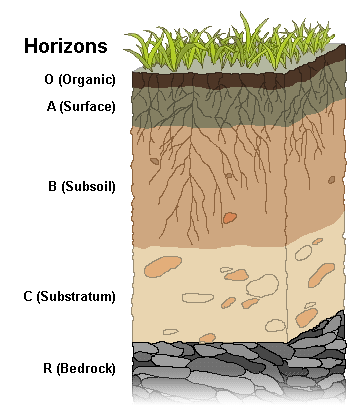Soil horizons
A soil horizon is a layer parallel to the soil surface whose physical, chemical and biological characteristics differ from the layers above and beneath. Horizons are defined in many cases by obvious physical features, mainly color and texture.
Main soil horizons
Every main soil horizons gets a capital letter to indicate them. Each capital letter represent the kind of soil present. The two last letters often indicate stiffer and denser material which can be a parent rock for the soils on top. The main indications, indicate in which environment the soil was created.
| Sub horizon | Identification |
|---|---|
| H/P | (humus) Consist of organic material at the surface. This material has been exposed to water for a long time. |
| O | (organic matter) Consist of organic material at the surface. This material has been exposed to water not more than a few times. |
| A | (topsoil) Consist of mineralic material and formed close to the surface. In the mineral fraction some accumulation of humified organic material can be found. |
| E | (eluvium) Consist of mineralic material and formed due to eluviation. Clay, iron, humus and/or aluminum are transported downward outside this horizon due to drainage and soilmaking processes. |
| B | (subsoil) Consist of mineralic material, which has no or very less in common with its parent soil. It is made due to the following process: pedogenesis, mostly with the formation of iron oxides and clay minerals. |
| C | (parent material) The deposit at Earth's surface from which the soil developed. It is formed either in deposits or it formed from weathering of residual bedrock. |
| R | (bedrock) A mass of rock such as granite, basalt, quartzite, limestone or sandstone that forms the parent material for some soils - if the bedrock is close enough to the surface to weather. This is not soil and is located under the C horizon. |
| Transition horizons will get the letter of both horizons, for example: AE, BR, etc. | |
| A fully mixed horizon where both horizons can be recognized will be determined as: A/C,A/E, etc. | |
Sub soil horizons
To indicate loose material or an highly unsuspected material, small letters are used. This letters will appear in combination with a capital letter described above. A soil horizon can have more small letters.
| Horizon | Identification |
|---|---|
| a | Strongly converted organic material (sapric) or with an A-horizon it can indicate anthropogenic parts. |
| b | A buried horizon. |
| c | Accumulation of concretions. |
| d | Root restricting layer. |
| e | Decomposed organic material. (hemic) |
| f | Faunal accumulations in A horizons. |
| g | Gley spots, the result of oxidation and reduction. |
| h | Accumulation of organic matter in mineral soil horizons (Ah, Bh). |
| i | Light converted organic material. (fibric) |
| j | Sporadically bleached. |
| k | Accumulation of calciumcarbonate. |
| m | Strongly cemented, consolidated or hardened. Mostly used with an extra letter which indicates the source of the material. |
| n | Accumulation of natrium. |
| p | Disturbance by plowing or another form of tillage. |
| q | Accumulation of silica. |
| r | Strong reduction due to the influence of groundwater. |
| s | Accumulation of iron-and/or aluminumoxides (sesquioxide) |
| t | Enrichment of clay due to washout. (illivation) |
| w | In situ weathering which is visible in the amount of clay, color or structure. |
| x | Presence of a fragipan. |
| y | Accumulation of gypsum. |
| z | Accumulation of salts which are better soluble than gypsum. |
References
- IUSS Working Group WRB (2015). "World Reference Base for Soil Resources 2014, Update 2015" (PDF). World Soil Resources Reports 106, FAO, Rome.

